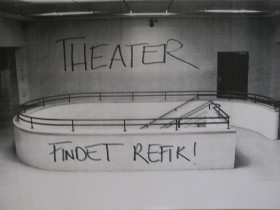A Conversation about the Exhibition “Obedience”
The exhibition “Obedience. An Installation in 15 Rooms by Saskia Boddeke & Peter Greenaway,” which has just been extended for two months, prompts extremely varied visitor responses. Atalya Laufer and Marc Wrasse regularly give guided tours of the exhibition. They talked to me recently about the experiences they’ve had, how they see the exhibition, and what they believe is at the root of visitors’ reactions.
Mirjam Wenzel: What form do your guided tours of the exhibition take?

Visitor in the “Golden Room” with manuscripts of the three monotheistic religions © Jewish Museum Berlin, photo: Jule Roehr
Marc Wrasse: We don’t so much guide visitors as accompany them on a three-step journey of discovery. We welcome the group and give a brief introductory talk, during which we point out that the Museum commissioned two artists to create the exhibition. Then, together with the visitors, we read aloud the relevant passage of the Bible—incidentally, the translation by Moses Mendelsohn—before leaving them to the exhibition.
Atalya Laufer: I prefer to use the translation by Martin Buber and Franz Rosenzweig.
Marc: But you too use roleplay, do you not, when reading the Bible story? That way, we make it clear that we want to explore the exhibition with our visitors and enjoy a shared experience. → continue reading

A scene from the theater play, “Findet Refik!” © Lernkultur – Institut für Bildungsforschung und Evaluation, photo: Katharina Obens
The recently approved introduction of upper secondary level teaching at the Refik-Veseli-School was a first for Kreuzberg 36, an inner-city district of Berlin, which is very popular. Now, local kids from the neighborhood called “Wrangelkiez” need no longer travel to other districts to study for the “Abitur,” Germany’s high school diploma. This is a major step towards assuring non-segregated educational opportunities in Kreuzberg
The 8th Integrated High School in the downtown district of Kreuzberg-Berlin sealed its partnership with the Jewish Museum Berlin in June 2012. Prior to that, all the staff and pupils had voted on a new name for their school and decided to call it the Refik-Veseli-School. For during a study trip to Israel, pupils had visited the Yad Vashem Museum and learned about the history of Refik Veseli—a man acknowledged being Righteous Among the Nations.
Refik Veseli was a 17-year-old apprentice in a photo studio in Tirana, Albania, when he first met the Jewish photographer Mosche Mandil, who had fled Yugoslavia to escape the National Socialists. But in 1943 the Germans invaded Albania too, and things became much more dangerous for Jews. The Veseli family owned a house in Kruje and decided to hide Mosche Mandil and his family there. It turned out to be a three-year commitment. → continue reading

A “graphic recording” of the ways in which schools and museums can cooperate more closely on diversity issues © JMB, photo: Jule Roehr
We learned a lot in the course of our three-year “Vielfalt in Schulen” [ViS] program, which the Jewish Museum Berlin [JMB] carried out in cooperation with the Deutsche Kinder- und Jugendstiftung [DKJS, German Foundation for Children and Young People], with funding courtesy of the Stiftung Mercator [Mercator Foundation]. Journalist Alke Wierth of the national daily paper, tageszeitung, recently helped us weigh up the results.
Alke Wierth: Looking back on what you had in mind when launching the “ViS” program, can you recall at which point you first thought: “Things are not going the way we planned?”
Rosa Fava, project leader, JMB: It was right at the start, at one of the meetings with the participating schools, where we discussed their expectations of the program. A lot of the stuff talked about there made me wonder: What on earth has this to do with our concept?
For example?
→ continue reading


